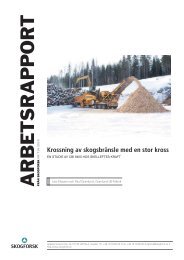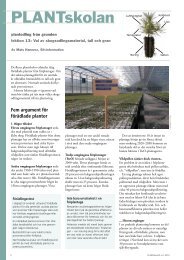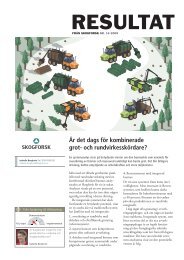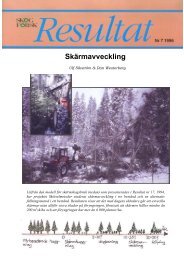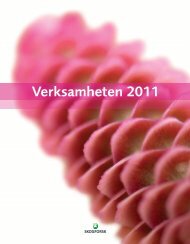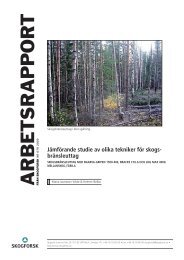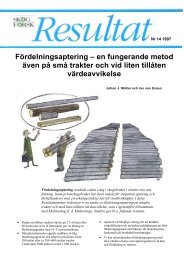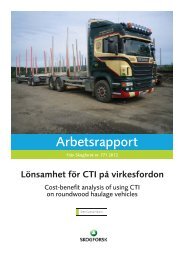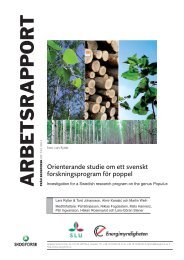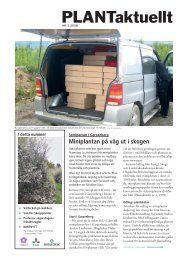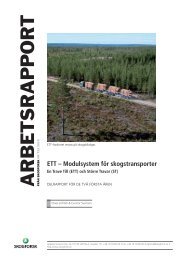Download pdf - Skog og landskap
Download pdf - Skog og landskap
Download pdf - Skog og landskap
Create successful ePaper yourself
Turn your PDF publications into a flip-book with our unique Google optimized e-Paper software.
47. BOOM AUTOMATION<br />
Löfgren Björn<br />
<strong>Sk<strong>og</strong></strong>forsk, Uppsala, Sweden<br />
bjorn.lofgren@sk<strong>og</strong>forsk.se<br />
To stay competitive internationally, the Swedish forestry sector must increase its productivity by<br />
2 to 3% annually. There are a variety of ways in which productivity can be increased. One<br />
option is to develop remote-controlled or unmanned machines, thus reducing the need for<br />
operator intervention. Another option — and one that could be achieved sooner than full<br />
automation — would be to make some functions semi-automatic. Semi-automatic operation of<br />
the knuckle boom and felling head in particular would create “mini-breaks” for the operators,<br />
thereby reducing mental and physiol<strong>og</strong>ical stress. It would also reduce training time and<br />
increase the productivity of a large proportion of operators.<br />
The objective of this work has been to develop and evaluate algorithms for simplified boom<br />
control on a forwarder. Algorithms for so called boom tip control, as well as automatic boom<br />
functions have been introduced. The algorithms solve the inverse kinematics of kinematically<br />
redundant knuckle booms while maximizing lifting capacity. The boom tip control was evaluated<br />
– first by means of a kinematic simulation and then in a dynamic forest machine simulator. The<br />
results show that boom tip control is an easier system to learn in comparison to conventional<br />
control, which can lead to savings in production due to shorter learning times and operators<br />
being able to reach full production sooner. Boom tip control also creates less mental strain than<br />
conventional control, which in the long run will reduce mental stress on operators of forest<br />
machines. The maximum lifting capacity algorithm was then developed further to enable TCP<br />
path-tracking, which was also implemented and evaluated in the simulator.<br />
An evaluation of the fidelity of the dynamic forest machine simulator was performed to ensure<br />
validity of the results achieved with the simplified boom control. The results from the study show<br />
that there is good fidelity between the forest machine simulator and a real forest machine, and<br />
that the results from simulations are reliable. It is also concluded that the simulator was a useful<br />
research tool for the studies performed in the context of this thesis work.<br />
The work had two overall objectives. The first was to provide the industry and forestry sector with<br />
usable and verified ideas and results in the area of automation. This has been accomplished with<br />
the implementation of a simplified boom control and semi-automation on a forwarder in a recently<br />
started joint venture between a hydraulic manufacturer, a forest machine manufacturer and a<br />
forest enterprise. The second objective was to strengthen the research and development links<br />
between the forestry sector and technical university research. This has been accomplished<br />
through the thesis work itself and by a number of courses, projects and Masters Theses over the<br />
last three years. About 250 students in total have been studying forest machine technol<strong>og</strong>y in one<br />
way or the other.<br />
Keywords: Hydraulic manipulator, redundancy, kinematic control, local optimization, knuckle<br />
boom, forest machine, forwarder, boom tip control, joystick control, simulations, path following.<br />
75



